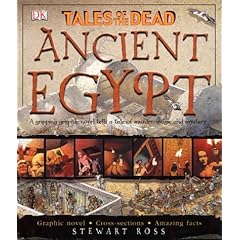
Introduction and Summary
“In a world full of traitors and thieves, who would you trust?” This is not your typical overview of ancient Egyptian civilization! The book Tales of the Dead: Ancient Egypt written by Stewart Ross and illustrated by Inklink and Richard Bonson deftly incorporates a mini-graphic novel into a factual overview with the exceptional detail you would expect of a Dorling Kindersley book. Geared for older readers, this blend of historical fiction with a non-fiction encyclopedic approach helps to capture young readers’ imaginations. It allows them to envision themselves living in ancient Egypt in a fresh, new way.
The introductory pages set the historical context for the characters of the mini-graphic novel in the book. Methen, a boy scribe, and Madja, a serving girl in a nobleman's court, happen upon tomb robbers, and get caught up in a plot of courtly intrigue, ultimately meeting the pharaoh herself, Sobekneferu. Their story is told in strips along the edges of the book pages, which serve to add more concrete historical information to the plot developing in the fictitious storyline. Different aspects of ancient Egyptian civilization are discussed along the way to give readers a better understanding of Egyptian society and religious life. Cross-sections of pyramids, town dwellings, drawings demonstrating the various steps of the mummification process, and other richly detailed pictures provide greater insight and cultural context for the story unfolding in the marginalia. In so doing, this book makes learning about life in ancient Egypt more dynamic for young readers and forges a more personal connection to the factual material presented.
Curriculum Connections
While not really suitable for a read-aloud book for the class, this would be a great book to make available to second grade students studying ancient Egypt. It would be a good addition to a classroom reading center where students could spend time with the book, or it could go home with students if teachers have a book borrowing system in the classroom. A map at the beginning of the book shows the geographic location of the ancient Egyptian civilization (2.4a), and subsequent pages elaborate more upon its cultural significance, architectural contributions, religious customs, and life along the Nile River (2.1, 2.4b).
Additional Resources
- National Geographic’s page on Egypt, Egypt: Secrets of an Ancient World, features a special section full of kids’ activities as well as lesson plans for educators.
- The Metropolitan Museum of Art (NYC) has a great web resource entitled The Art of Ancient Egypt, which utilizes their extensive collections to offer educators inventive ways to integrate ancient Egyptian art into their curriculum. The Virginia Museum of Art in Richmond, VA has a wonderful Egyptian slide kit from the MMA (The Art of Ancient Egypt, PS-109) available for educators to use through their Education and Statewide Partnership program.
- Carnegie Museum of Natural History has a teacher’s guide for life in ancient Egypt that includes vocabulary lists and activities.
- Fun links to additional Egyptian information and activities for students can be found at http://egypt.mrdonn.org/index.html.
General Information
- Book: Tales of the Dead: Ancient Egypt
- Author: Stewart Ross
- Illustrator: Inklink and Richard Bonson
- Publisher: DK Children
- Publication Date: 2003
- Pages: 32
- Grade Range: second to third grade
- ISBN: 078949857X
